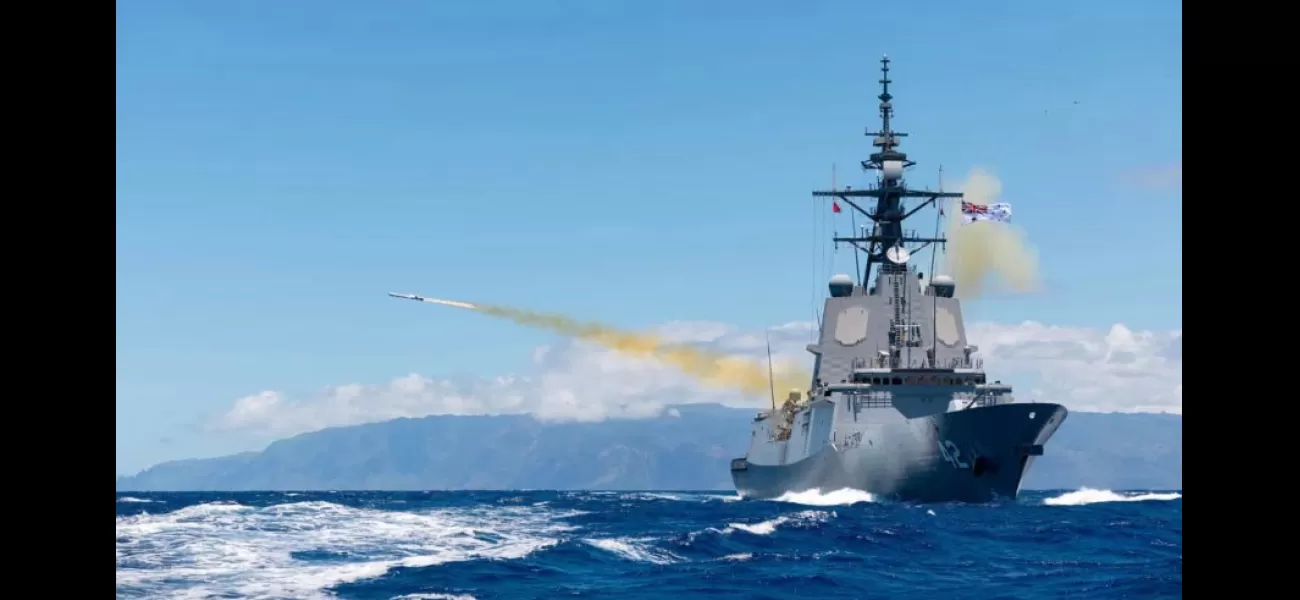US military has tested a budget-friendly bomb for taking down large ships.
US and allies recently conducted a drill targeting a big ship using long-range weapons, including a B-2 bomber for the first time.
July 28th 2024.

One of the most specialized and noteworthy aspects of the world's largest naval drills, held off the northern Hawaiian island of Kauai, has been making waves on both sides of the Pacific. In recent weeks, the United States and its allies have been practicing targeting and taking out a large surface ship with long-range weapons, including the use of a US Air Force B-2 bomber for the first time ever.
The significance of this exercise has not gone unnoticed by analysts, who see it as a potential game-changer in any potential conflict between the US and China. In a particularly notable test, the B-2 stealth bomber was able to successfully hit a decommissioned amphibious assault ship using a relatively inexpensive guided bomb. This test, known as QUICKSINK in the US Air Force, took place on July 19 and involved the sinking of the ex-USS Tarawa, a retired vessel that measured 250m in length and weighed 39,000 tons – comparable in size to a small aircraft carrier.
The success of this test has demonstrated the US military's proficiency in utilizing its most resilient weapons platform, the B-2 Spirit stealth bomber, to take down a major surface ship using a cost-effective guided bomb. As stated in a press release from the US Navy's 3rd Fleet, which led the exercise known as Rim of the Pacific 2024, this capability is an answer to the urgent need for quick and efficient neutralization of maritime threats across vast expanses of ocean, all while keeping costs to a minimum.
The B-2 bomber is widely recognized as the most advanced aircraft in the US military's arsenal. Its stealth capabilities allow it to penetrate heavily defended areas and fly at high altitudes with a low chance of being detected by radar. This provides the B-2 with a unique vantage point, giving its sensors a view of the battlefield that would not be possible for lower-flying planes. When paired with relatively inexpensive and highly precise guided bombs with warheads weighing up to 907kg, the B-2 can effectively match the anti-ship capabilities of a submarine-launched torpedo without the inherent risks associated with submarine operations.
The potential impact of QUICKSINK on the People's Liberation Army Navy (PLAN) of China has not gone unnoticed. In the event of a conflict in the western Pacific, such as around hotspots like Taiwan, the Philippines, or the southern islands of Japan, the use of QUICKSINK from a B-2 would give the PLAN a lot to consider. As Carl Schuster, former head of the US Pacific Command Joint Intelligence Centre, put it, "You cannot ignore a weapon that can sink a 25,000-plus-ton ship with one hit." This anti-maritime capability demonstrated by the B-2 would serve to constrain, if not deter, any PLAN operations in the eastern Pacific.
On paper, China holds distinct advantages in any conflict close to its home shores. With thousands of missiles on the Chinese mainland, the world's largest navy, and the ability to provide air cover to its ships through land-based aircraft, China has a formidable defense. However, the B-2, along with other systems tested during RIMPAC, could offset some of China's advantages by providing long-range firepower. As Professor Alessio Patalano, an expert in war and strategy from King's College in London, noted, "It extends the range at which potential enemies can be held at risk through advanced weapons whilst retaining a considerable degree of stealth. It basically says, you are not safe no matter where you are in this vast theatre."
In conclusion, the recent success of QUICKSINK during RIMPAC has highlighted the US military's ability to effectively neutralize maritime threats over large distances at a minimal cost. This capability has the potential to significantly impact any future conflicts in the Pacific and has already garnered attention from both sides of the Pacific. With the B-2's demonstrated anti-ship capabilities, the US military has shown that it can match the firepower of a submarine without the inherent risks, giving potential adversaries plenty to consider.
An extraordinary segment of the world's largest naval exercises off the northern Hawaiian island of Kauai has caught the attention of both sides of the Pacific. In a recent demonstration, the US and its allies showcased their ability to take down a large surface ship using long-range weapons. This included a historic moment as a US Air Force B-2 bomber participated in the drill for the first time.
One particular test stood out to analysts as it could have significant implications in a hypothetical conflict between the US and China. The B-2 stealth bomber successfully struck a decommissioned amphibious assault ship with a low-cost guided bomb, marking a major milestone in the military's capabilities. The weapon, known as QUICKSINK, was put to the test on July 19th when the B-2 took part in the sinking of the ex-USS Tarawa. This massive vessel, measuring 250 meters in length and weighing 39,000 tons, is comparable in size to a small aircraft carrier.
The success of this exercise not only proves the US military's ability to utilize one of its most resilient weapons, the B-2 Spirit, but also showcases the effectiveness of a relatively inexpensive guided bomb in taking down a major surface ship. According to a press release from the US Navy's 3rd Fleet, which led the Rim of the Pacific 2024 exercises, this capability provides a solution to the urgent need of neutralizing maritime threats over vast expanses of ocean without incurring high costs.
The B-2 bomber is the most advanced aircraft in the US military's arsenal, known for its stealth capabilities that allow it to penetrate heavily defended areas with minimal risk of detection. This gives the B-2 a unique advantage in gathering intelligence and gaining a strategic overview of the battlefield, something that would not be possible for lower-flying planes. When paired with precision-guided bombs that are relatively inexpensive and highly effective, with warheads up to 907kg, the B-2 can achieve the same anti-ship lethality as a submarine-launched torpedo without the drawbacks of a submarine.
The US Air Force Research Lab elaborates on this point, stating that while a Navy submarine can launch and destroy a ship with a single torpedo, it also gives away its location and becomes a target. With QUICKSINK, the Air Force can achieve similar results from the air at a much faster rate and over a larger area, making it a more feasible option in the event of a conflict.
QUICKSINK was first tested in 2022 when an F-15 fighter jet released a GBU-31 Joint Direct Attack Munition, successfully destroying a full-scale surface target in the Gulf of Mexico. Analysts believe that the addition of QUICKSINK to the B-2's capabilities will give China's People's Liberation Army Navy a lot to consider in the event of a conflict in the western Pacific, especially around hotspots like Taiwan, the Philippines, and the southern islands of Japan.
Carl Schuster, former head of the US Pacific Command Joint Intelligence Centre, describes this development as very significant. He believes that the B-2's anti-maritime capability will act as a constraint or even a deterrent for the Chinese Navy's operations east of Taiwan or off the coast of the Philippines. "You cannot ignore a weapon that can sink a 25,000-plus-ton ship with one hit," Schuster adds.
On paper, China holds distinct advantages in any conflict close to its shores. With thousands of missiles on the mainland, the world's largest navy, and the ability to provide air cover from land-based aircraft, it has a formidable defense. However, systems like the B-2 and other weapons tested at RIMPAC could level the playing field by extending the range at which potential enemies can be held at risk through advanced weapons and maintaining a considerable degree of stealth. It essentially sends a message that no matter where you are in this vast theater, you are not safe.
The significance of this exercise has not gone unnoticed by analysts, who see it as a potential game-changer in any potential conflict between the US and China. In a particularly notable test, the B-2 stealth bomber was able to successfully hit a decommissioned amphibious assault ship using a relatively inexpensive guided bomb. This test, known as QUICKSINK in the US Air Force, took place on July 19 and involved the sinking of the ex-USS Tarawa, a retired vessel that measured 250m in length and weighed 39,000 tons – comparable in size to a small aircraft carrier.
The success of this test has demonstrated the US military's proficiency in utilizing its most resilient weapons platform, the B-2 Spirit stealth bomber, to take down a major surface ship using a cost-effective guided bomb. As stated in a press release from the US Navy's 3rd Fleet, which led the exercise known as Rim of the Pacific 2024, this capability is an answer to the urgent need for quick and efficient neutralization of maritime threats across vast expanses of ocean, all while keeping costs to a minimum.
The B-2 bomber is widely recognized as the most advanced aircraft in the US military's arsenal. Its stealth capabilities allow it to penetrate heavily defended areas and fly at high altitudes with a low chance of being detected by radar. This provides the B-2 with a unique vantage point, giving its sensors a view of the battlefield that would not be possible for lower-flying planes. When paired with relatively inexpensive and highly precise guided bombs with warheads weighing up to 907kg, the B-2 can effectively match the anti-ship capabilities of a submarine-launched torpedo without the inherent risks associated with submarine operations.
The potential impact of QUICKSINK on the People's Liberation Army Navy (PLAN) of China has not gone unnoticed. In the event of a conflict in the western Pacific, such as around hotspots like Taiwan, the Philippines, or the southern islands of Japan, the use of QUICKSINK from a B-2 would give the PLAN a lot to consider. As Carl Schuster, former head of the US Pacific Command Joint Intelligence Centre, put it, "You cannot ignore a weapon that can sink a 25,000-plus-ton ship with one hit." This anti-maritime capability demonstrated by the B-2 would serve to constrain, if not deter, any PLAN operations in the eastern Pacific.
On paper, China holds distinct advantages in any conflict close to its home shores. With thousands of missiles on the Chinese mainland, the world's largest navy, and the ability to provide air cover to its ships through land-based aircraft, China has a formidable defense. However, the B-2, along with other systems tested during RIMPAC, could offset some of China's advantages by providing long-range firepower. As Professor Alessio Patalano, an expert in war and strategy from King's College in London, noted, "It extends the range at which potential enemies can be held at risk through advanced weapons whilst retaining a considerable degree of stealth. It basically says, you are not safe no matter where you are in this vast theatre."
In conclusion, the recent success of QUICKSINK during RIMPAC has highlighted the US military's ability to effectively neutralize maritime threats over large distances at a minimal cost. This capability has the potential to significantly impact any future conflicts in the Pacific and has already garnered attention from both sides of the Pacific. With the B-2's demonstrated anti-ship capabilities, the US military has shown that it can match the firepower of a submarine without the inherent risks, giving potential adversaries plenty to consider.
An extraordinary segment of the world's largest naval exercises off the northern Hawaiian island of Kauai has caught the attention of both sides of the Pacific. In a recent demonstration, the US and its allies showcased their ability to take down a large surface ship using long-range weapons. This included a historic moment as a US Air Force B-2 bomber participated in the drill for the first time.
One particular test stood out to analysts as it could have significant implications in a hypothetical conflict between the US and China. The B-2 stealth bomber successfully struck a decommissioned amphibious assault ship with a low-cost guided bomb, marking a major milestone in the military's capabilities. The weapon, known as QUICKSINK, was put to the test on July 19th when the B-2 took part in the sinking of the ex-USS Tarawa. This massive vessel, measuring 250 meters in length and weighing 39,000 tons, is comparable in size to a small aircraft carrier.
The success of this exercise not only proves the US military's ability to utilize one of its most resilient weapons, the B-2 Spirit, but also showcases the effectiveness of a relatively inexpensive guided bomb in taking down a major surface ship. According to a press release from the US Navy's 3rd Fleet, which led the Rim of the Pacific 2024 exercises, this capability provides a solution to the urgent need of neutralizing maritime threats over vast expanses of ocean without incurring high costs.
The B-2 bomber is the most advanced aircraft in the US military's arsenal, known for its stealth capabilities that allow it to penetrate heavily defended areas with minimal risk of detection. This gives the B-2 a unique advantage in gathering intelligence and gaining a strategic overview of the battlefield, something that would not be possible for lower-flying planes. When paired with precision-guided bombs that are relatively inexpensive and highly effective, with warheads up to 907kg, the B-2 can achieve the same anti-ship lethality as a submarine-launched torpedo without the drawbacks of a submarine.
The US Air Force Research Lab elaborates on this point, stating that while a Navy submarine can launch and destroy a ship with a single torpedo, it also gives away its location and becomes a target. With QUICKSINK, the Air Force can achieve similar results from the air at a much faster rate and over a larger area, making it a more feasible option in the event of a conflict.
QUICKSINK was first tested in 2022 when an F-15 fighter jet released a GBU-31 Joint Direct Attack Munition, successfully destroying a full-scale surface target in the Gulf of Mexico. Analysts believe that the addition of QUICKSINK to the B-2's capabilities will give China's People's Liberation Army Navy a lot to consider in the event of a conflict in the western Pacific, especially around hotspots like Taiwan, the Philippines, and the southern islands of Japan.
Carl Schuster, former head of the US Pacific Command Joint Intelligence Centre, describes this development as very significant. He believes that the B-2's anti-maritime capability will act as a constraint or even a deterrent for the Chinese Navy's operations east of Taiwan or off the coast of the Philippines. "You cannot ignore a weapon that can sink a 25,000-plus-ton ship with one hit," Schuster adds.
On paper, China holds distinct advantages in any conflict close to its shores. With thousands of missiles on the mainland, the world's largest navy, and the ability to provide air cover from land-based aircraft, it has a formidable defense. However, systems like the B-2 and other weapons tested at RIMPAC could level the playing field by extending the range at which potential enemies can be held at risk through advanced weapons and maintaining a considerable degree of stealth. It essentially sends a message that no matter where you are in this vast theater, you are not safe.
[This article has been trending online recently and has been generated with AI. Your feed is customized.]
[Generative AI is experimental.]
0
0
Submit Comment





